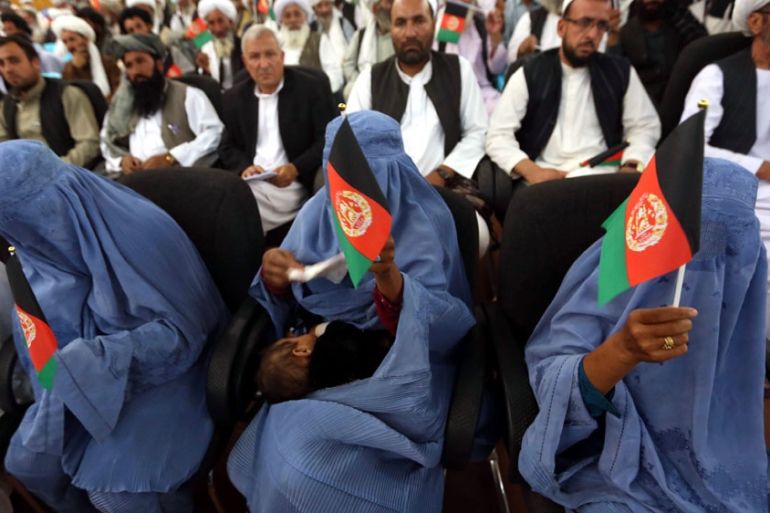A domino effect in Afghanistan
Violence in northern Afghanistan threatens the country’s vulnerable populations and jeopardises nationwide stability.

Across a 12,500km expanse of well-irrigated valleys, Faryab province in northern Afghanistan used to be a stable, economically self-sufficient home to nearly one million multiethnic inhabitants.
But today, Faryab simmers dangerously. Against the backdrop of the US government’s latest extension of its military commitment to Afghanistan, it is worth noting that the province is precariously situated along the same political faultlines that recently rattled Kunduz province.
Keep reading
list of 4 items‘Mama we’re dying’: Only able to hear her kids in Gaza in their final days
Europe pledges to boost aid to Sudan on unwelcome war anniversary
Birth, death, escape: Three women’s struggle through Sudan’s war
Continued instability in Faryab and its adjacent provinces risks undermining the country at a time when Afghanistan is haemorrhaging on all fronts.
Undermining the government
|
|
| Why is Obama changing his mind on Afghanistan? |
It is no secret that Faryab has been a hotbed of insurgent activity since the civil war of the 1990s. Its lucrative natural resources and agriculturally viable land have been embroiled in a tug-of-war between two political parties, Jamaat-e-Islami and Junbish-i-Mill Islami.
But for several years, the area has also become a safe haven to fighters from the Islamic Movement of Uzbekistan (IMU) and the Quetta Shura Taliban who have both sought to establish operational bases in a collaborative attempt to subvert the central government.
In fact, a Quetta Shura leader died in Faryab on October 5, during a battle with the Afghan National Security Forces (ANSF) following a Taliban assault on Maymana, the provincial capital, in which almost 10 percent of the population lives.
Also read: Afghanistan: The other refugee crisis
This came in the wake of several clashes last month in which the Taliban not only attacked Maymana, but also captured Qaisar and Almar districts from the ANSF, forcing school closures, under Islamic law, and preventing many households from farming – the main source of livelihood in the province.
Roughly 30 percent of the province’s populations live in Qaisar and Almar districts, which serve as strategic supply points for cross-border trade with Turkmenistan.
The current situation represents a drastic escalation of fighting from August of this year, when Afghanistan’s vice president (a member of Junbish-i-Milli Islami) and former Northern Alliance commander, General Ahmad Rashid Dostum, personally led clearance operations in the area with the Afghan military.
But with the ANSF forced to retreat due to insufficient equipment, Faryab remains vulnerable to further infiltration by IMU, Taliban, and the Islamic State of Iraq and the Levant (ISIL), to whom the IMU has pledged support.
If Faryab collapses, it will unleash a terrifying domino effect in an area Afghanistan cannot afford to lose. The only way the NUG and the international community can get ahead is to pick up the pieces before they fall.
In response, the rise in militias proves even more corrosive as it loosens the already-tenuous grasp of the National Unity Government. President Ashraf Ghani’s endorsement of Dostum assuming his role as a regional strongman and rallying his own militias against the Taliban insurrection in Faryab spells a clear message for the population: The central government has limited power to affect the change in an area.
Undermining the economy
The political erosion in the north is also an ominous indicator of the decline of President Ghani’s plan for stability and development.
Foreign direct investment fell by 30 percent in the first half of this year and economic growth slowed to two percent from an average of nine percent between 2003 and 2012.
Tucked in the hem of Turkmenistan, Faryab maintains a key geographic position for Afghanistan’s economic interests. Its location and resources are indispensable to the Afghan government’s strategy of regional trade along the historical Silk Road trade route and increasing foreign investment in Afghanistan’s natural resources and extractive industry.
![A young Afghan displaced from her home in Faryab province as the Afghan army carries out a full-scale military operation against militants [EPA]](/wp-content/uploads/2015/10/8acd88e7de57453d9ec9997b040f9096_18.jpeg)
Mostly an agricultural area containing marble and some oil reserves, Faryab is a transit point for the Turkmenistan-Afghanistan-Pakistan-India (TAPI) pipeline.
With an estimated revenue yield of $400m a year, the pipeline not only reinforces the regional economic links coveted by Ghani, its revenue would help substantially displace the donor aid that currently furnishes more than 90 percent of Afghanistan’s budget.
Instability in Faryab also threatens to exacerbate a different power struggle. The Sheberghan gas fields in neighbouring Jowzjan province have been tapped as a critical resource in meeting Afghanistan’s projected energy need for 3,000 megawatts (MW) by 2020.
Also read: Kunduz was always vulnerable
Currently, the country’s capacity is limited to approximately 600MW – Kabul alone operates on a regular 150MW shortage.
According to some reports, Afghanistan demands only five percent of what a country such as the United Kingdom requires, despite serving only double the number of people.
To meet Afghanistan’s energy goals, the Sheberghan Gas Development Project, funded by the United States Agency for International Development, is expected to deliver 200MW of power by the end of 2017, but escalated insecurity could compromise the infrastructure anticipated for power transmission from Sheberghan to Puli Khumri in Baghlan province.
Undermining the population
For the 15,000 Afghans displaced by fighting in Faryab and its surrounding areas, the writing is on the wall. The central government and the military at best represent a filigree of governance, its fragility belied by political platitudes.

The economy fares no better. Security continues to threaten local lives forcing people into resource-poor mountainous areas. While aid organisations like the Norwegian Council on Refugees are doing what they can to remedy the situation, the government still lacks the capacity and infrastructure to handle mass population movements.
The sustained deluges of violence not only stymie efforts to access vulnerable populations, but they also jeopardise any gains in social development, such as education and health provision, including the establishment of the University of Faryab in 2012.
If Faryab collapses, it will unleash a terrifying domino effect in an area Afghanistan cannot afford to lose. The only way the NUG and the international community can get ahead is to pick up the pieces before they fall.
Morwari Zafar is an international security consultant and a PhD candidate in anthropology at the University of Oxford.
The views expressed in this article are the author’s own and do not necessarily reflect Al Jazeera’s editorial policy.
